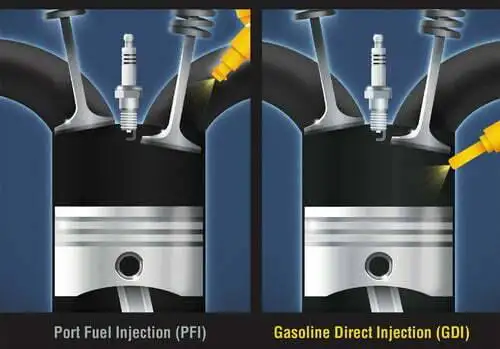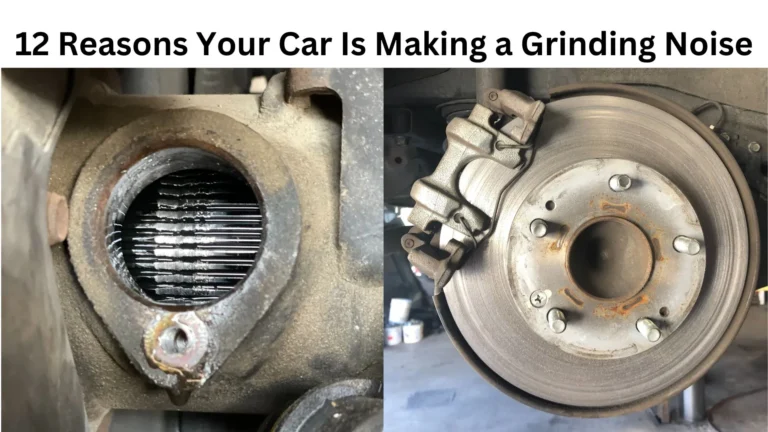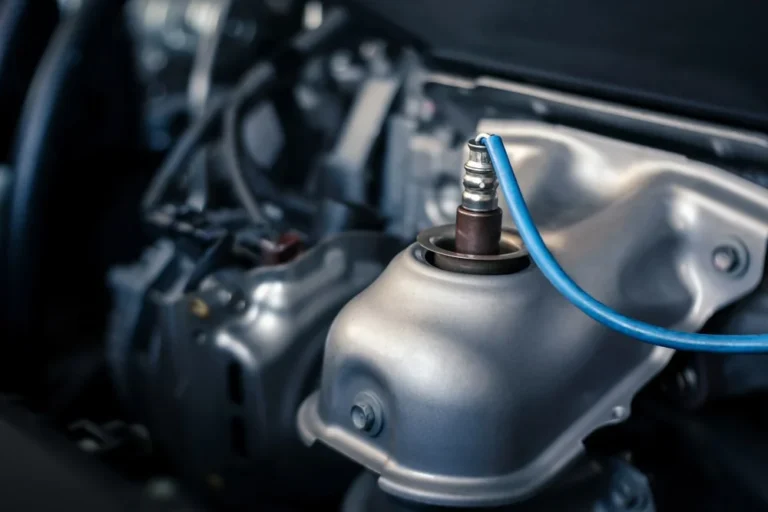What kind of Engine will propel your next car or truck? If you’ve been toying around with the idea of buying a diesel for its Fuel Economy (try nearly 50 mpg for the Volkswagen Jetta TDI), well, you may not need to give up on the trusted and familiar Gasoline Engine just yet.
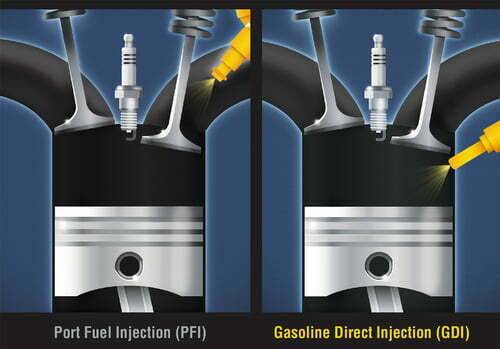 Difference between direct fuel injection and port fuel injection Difference between direct fuel injection and port fuel injection |
| Direct Injection Vs Port Fuel Injection |
That’s because one of the technologies that makes diesels so miserly on Fuel is coming to Gasoline Engines, too. It’s called Direct Injection, and it refers to how the fuel makes its way inside an Engine’s controlled-explosion room, better known as a combustion chamber.
In a garden-variety gasoline Engine with Fuel Injection, gasoline takes a more roundabout route than it does with the direct injection method. This indirect approach causes all manner of inefficiencies in burning the fuel, and it can result in a lot of usable energy getting wasted — and you not getting the most for the money you spent at the pump.
In a Direct Injection Engine, however, the fuel skips the waiting period it would have to endure inside a standard engine and instead proceeds straight to the combustion chamber. This allows the Fuel to burn more evenly and thoroughly. For the driver, that can translate to Better Mileage and greater power to the wheels.
In the past, Direct Injection posed too many technical hurdles to make it worthwhile for mass market gasoline automobiles. But with advances in technology and greater pressure to make cars run more cleanly and efficiently, it looks as if gasoline direct injection — or GDI as it’s referred to in industry lingo — is here to stay. In fact, most of the major car manufacturers make or plan to soon introduce gasoline cars that take advantage of this fuel saving and performance enhancing system.
For the lay individual, the labyrinth of hoses, wire harnesses, manifolds and tubing beneath a car hood might appear intimidating. But when it comes to the gasoline engine, just know this: It needs fuel, air (oxygen, to be precise) and spark in order to operate.
Direct Injection Engine Differences
The two most critical differences between a Direct Injection Engine and a standard gasoline engine are how they Deliver Fuel and how the fuel mixes with incoming air. These basic premises make a tremendous difference in an engine’s overall efficiency.
First, the fuel travels via pump from the fuel tank, through the fuel line and into fuel injectors that are mounted into the engine. The Injectors spray gasoline into the air Intake Manifold, where fuel and air mix together into a fine mist. At precisely timed intervals, intake valves open, corresponding to the different cylinders of the engine. As a cylinder’s intake valve opens, a piston in that cylinder descends, sucking the fuel-air mist from the air manifold above into the chamber below. As the piston ascends once more, it squeezes (compresses) the Fuel-Air mix until it is nearly nine times as dense as it was to begin with. Then, that cylinder’s designated spark plug fires, igniting the chamber into a high-pressure, high-energy explosion. This little bang pushes the piston back down with tremendous force, causing it to turn the crankshaft and ultimately send power to the wheels.
Got that? Pretty complicated, huh? It works, but from an engineering standpoint, it leaves much to be desired, and it’s pretty wasteful.
With a direct injection engine, however, the fuel gets to skip a step and add a bit of efficiency. Instead of hanging out in the air intake manifold, fuel is squirted directly into the combustion chamber. With an assist from modern engine management computers, the fuel gets burned right where it’s needed, when it’s needed.
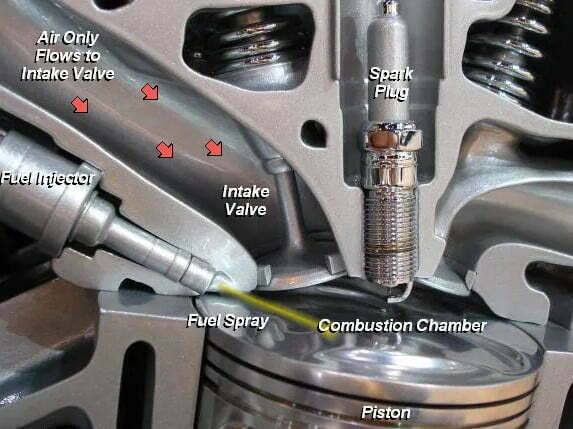 GDI Cylinder Cutaway view GDI Cylinder Cutaway view |
| GDI Engine Piston Cutaway |
Direct Injection Engines literally give you more bang for your buck, for two main reasons. One, they use a “leaner” fuel-air mixture ratio. Second, the way the fuel disperses inside the chamber allows it to burn more efficiently. Let’s take a quick look at each.
The ratio of air to fuel as it burns in an engine will have certain, predictable effects on engine performance, emissions of pollutants and fuel efficiency. When the amount of air in the mixture is high, compared to the amount of fuel, it’s known as a “lean” mixture. When the reverse is the case, it’s called a “rich” fuel mixture.
Direct Injection Engines use a mixture of 40 or more parts air to one part fuel, written as 40:1. That compares to a normal gasoline engine’s mix of 14.7:1. A leaner mixture allows fuel to be burned much more conservatively.
A second efficiency plus for Direct Injection Engines is that they can burn their fuel more completely. The Fuel can be squirted directly where the combustion chamber is hottest — in a gasoline engine that means it ends up close to the spark. With a traditional gasoline engine, the fuel air mixture disperses widely within the chamber, leaving a substantial amount unburned and therefore ineffective.
So what about the rest of the engine? Do direct injection engines represent a radical departure from the known and accepted principles of internal combustion?
The short answer is “no.” To be sure, direct injection engines do use a few special bits and technical tricks:
A nifty piece of hardware called a fuel rail, to distribute fuel to the injectors
Special programming for the engine management computer to handle the calculations of flow rate, fuel droplet size, emissions controls and other things you don’t want to think about while driving
Special catalytic converters to handle Direct Injection Engines’ notoriously high oxides of nitrogen emissions (NOx)
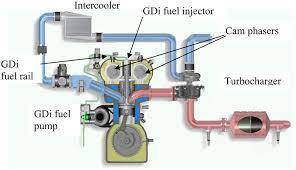 |
| GDI And Turbocharging |
The NOx issue notwithstanding, Gasoline Direct Injection Engines get high marks in particular for their cleaner emissions. It’s for this reason that numerous engine companies have toiled to build two-stroke versions of the gasoline direct injection engine.
While four-strokes are found on most automobiles and street-legal motorcycles, two-strokes rule when it comes to off-road motorcycles, small boat and personal watercraft engines and many of the motorbikes that serve as primary transportation in developing nations.

